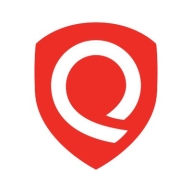

Qualys TotalCloud and Varonis Platform compete in the cybersecurity and data protection category. While both offer strong features, Qualys TotalCloud appears to have the upper hand with its comprehensive vulnerability management and integration features.
Features: Qualys TotalCloud stands out with its vulnerability management and reporting capabilities, offering a unified view of risks that reduces vulnerability assessment time by 70-80%. Its integration with Power BI enhances data visualization. Moreover, Qualys TotalCloud focuses on automation and integration across environments, crucial for cloud management. On the contrary, Varonis Platform provides strong data security with detailed insights into access and patterns, featuring the DatAdvantage for granular data control. It also excels in data-centric security and user behavior analytics.
Room for Improvement: Qualys TotalCloud users suggest improvements in clearer licensing models, domain name resolution, and enhanced scanning capabilities. Users also desire better policy compliance and dashboard customization for regulatory frameworks. For Varonis Platform, the complexity of its interface and slower calculation processing for large datasets are noted, along with desires for better remediation support and DLP capabilities.
Ease of Deployment and Customer Service: Qualys TotalCloud offers flexible deployment in public and hybrid clouds, although users indicate support response times could be improved. Generally positive customer service feedback is noted. Varonis Platform provides stable on-premises and cloud deployments, with users desiring more streamlined issue resolutions and improved communication during troubleshooting.
Pricing and ROI: Qualys TotalCloud is perceived as potentially costly, but its extensive features and efficiencies justify the expense by reducing workload significantly. Varonis Platform is generally viewed as more expensive, especially for smaller businesses, though it offers substantial data security benefits with positive ROI for larger enterprises. Qualys provides more cost-effective licensing options in integration scenarios.


TotalCloud is the Qualys approach to Cloud Native Application Protection Platform (CNAPP) for cloud infrastructure and SaaS environments. With TotalCloud, customers extend TruRisk insights (transparent cyber risk scoring methodology) from the Qualys Enterprise TruRisk Platform to their cloud environments allowing for a seamless unified view of cyber risk across on-prem, hybrid, and multi-cloud environments.
Features and capabilities of Qualys TotalCloud include, but are not limited to:
Discover: Complete visibility and insights into cyber-risk exposure across multi-cloud. Continuously discover and monitor all your workloads across a multi-cloud environment for a 360-degree view of your cloud footprint. Identify known and previously unknown internet-facing assets for 100% visibility and tracking of risks.
Assess: Comprehensive cloud-native assessments with FlexScanTM. Extensive scanning capabilities with Qualys FlexScan, including no-touch, agentless, API- and snapshot-based scanning, along with agent- and network-based scanning for in-depth assessment. Use these multiple scanning methods to scan a workload to get a unified and comprehensive view of vulnerabilities and misconfigurations.
Prioritize: Unified security view to prioritize cloud risk with TruRiskTM. Experience a unified risk-based view of cloud security with insights across workloads, services, and resources. Qualys TruRisk quantifies security risk by workload criticality and vulnerabilities; it correlates with ransomware, malware, and exploitation threat intelligence to prioritize, trace, and reduce risk.
Defend: Real-time protection against evolving and unknown threats with InstaProtectTM. Qualys enables continuous monitoring of all cloud assets to ensure they are protected against threats and attacks at runtime. Qualys keeps your cloud runtime safe by detecting known and unknown threats across the entire kill chain in near real-time across a multi-cloud environment.
Remediate: Fast remediation with QFlow – no code, drag-and-drop workflows. The integration of QFlow technology into Qualys TotalCloud saves security and DevOps teams valuable time and resources. Automation and no-code, drag-and-drop workflows help simplify the time-consuming operational tasks of assessing vulnerabilities on ephemeral cloud assets, alerting on high-priority threats, remediating misconfigurations, and quarantining high-risk assets.
Varonis Platform specializes in network security and data monitoring with modules for alerting, data classification, and access management, benefiting environments like Microsoft 365.
Varonis is designed to secure data by auditing and tracking data movement. It leverages data alert and classification modules to identify and manage sensitive information. The platform enhances network security by alerting users to unexpected data modifications and deletions, crucial for effective data loss prevention. It supports unstructured data management, ensuring proper data access and permission controls. Known for its 24/7 support, Varonis offers comprehensive analytics and unified reporting, helping prevent data overexposure and facilitating compliance efforts.
What are the key features of Varonis Platform?
What benefits should be highlighted in user reviews?
Varonis Platform is widely utilized in industries needing stringent data confidentiality and management, such as finance and healthcare, for tracking data modifications and unauthorized access. Enterprises deploy it to manage permissions within large datasets, benefiting Microsoft 365 environments. While Varonis requires enhancements in cloud integration, the current deployment is often based on-premises, with attention to addressing the security needs and effective data handling for critical infrastructure.
We monitor all SaaS Security Posture Management (SSPM) reviews to prevent fraudulent reviews and keep review quality high. We do not post reviews by company employees or direct competitors. We validate each review for authenticity via cross-reference with LinkedIn, and personal follow-up with the reviewer when necessary.